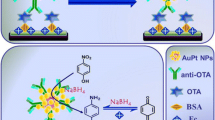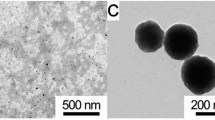Abstract
An ultrasensitive and nonenzymatic electrochemical sandwich-type immunoassay using covalent organic framework (COF-LZU1) material applied as a fixed matrix was developed for the determination of C-reactive protein (CRP). COFs with large specific surface area, good conductivity and stability were employed for functionalisation of the surface. Au nanoparticles were loaded on COF-LZUl to immobilise the CRP antibody (anti-CRP) on the surface of a glassy carbon electrode. Microwave method was employed for the synthesis of the Pt/Ru/C nanoparticles to imitate the protein enzyme with high catalytic activity. The as-synthesised activated carbon–supported bimetallic Pt/Ru/C nanoparticle composite was used to label secondary CRP antibody because it exhibited excellent catalytic behaviour toward hydrogen peroxide. After incubation of CRP, Pt/Ru/C-labelled anti-CRP was combined with CRP through specific antibody-antigen recognition process. The reduction current of H202 at − 0.2 V catalysing by tag Pt/Ru/C as measured by a chronoamperometric method is proportional to the concentration of CRP. Under optimal experimental conditions, employing chronoamperometry to investigate the CRP, the obtained linear range was 0.2 to 20 ng/mL with a detection limit of 0.1 ng/mL. This immunosensor provides an attractive platform for the applicability of COF-LZU1 materials and Pt/Ru/C nanoparticles in electrochemical assays.

An ultrasensitive and nonenzymatic electrochemical immunoassay using covalent organic frameworks (COF-LZU1) material as the fixed matrix was developed for the detection of C-reactive protein (CRP). Microwave method was employed to synthesis the bimetallic metal composites Pt/Ru/C nanoparticles, which exhibited excellent catalytic behavior toward small molecules H2O2. COFs with large specific surface area, good conductivity and stability were employed for surface functionalization. Our proposed biosensor is highly sensitive, with the detection limit of 0.1 ng/mL.






Similar content being viewed by others
References
Kim C, Ahn J, Kim J, Choi J, Lim K, Park TJ, Heo NS, Lee HG, Kim J, Choi Y (2013) CRP detection from serum for chip-based point-of-care testing system. Biosens Bioelectron 41:322–327
Hennessey H, Afara N, Omanovic S, Padjen AL (2009) Electrochemical investigations of the interaction of C-reactive protein (CRP) with a CRP antibody chemically immobilized on a gold surface. Anal Chim Acta 643:45–53
Liu T, Hu R, Zhang X, Zhang K, Liu Y, Zhang X, Bai R, Li D, Yang Y (2016) Metal-organic frameworks nanomaterials as novel signal probes for electron transfer mediated ultrasensitive electrochemical immunoassay. Anal Chem 88:12516–12523
Hermann M, Fischer D, Hoffmann MM, Gasser T, Quitzau K, Meinertz T, Münzel T, Lüscher TF (2012) CRP and CD14 polymorphisms correlate with coronary plaque volume in patients with coronary artery disease--IVUS substudy of the ENCORE trials. Atherosclerosis 220:172–176
Veeranna V, Zalawadiya SK, Niraj A, Kumar A, Ference B, Afonso L (2013) Association of novel biomarkers with future cardiovascular events is influenced by ethnicity: results from a multi-ethnic cohort. Int J Cardiol 166:487–493
May A, Wang TJ (2007) Evaluating the role of biomarkers for cardiovascular risk prediction: focus on CRP, BNP and urinary microalbumin. Expert Rev Mol Diagn 7:793–804
Mygind ND, Harutyunyan MJ, Mathiasen AB, Ripa RS, Thune JJ, Gøtze JP, Johansen JS, Kastrup J (2011) The influence of statin treatment on the inflammatory biomarkers YKL-40 and HsCRP in patients with stable coronary artery disease. Inflamm Res 60:281–287
Yang T, Gao Y, Liu Z, Xu J, Lu L, Yu Y (2017) Three-dimensional gold nanoparticles/prussian blue-poly(3,4-ethylenedioxythiophene) nanocomposite as novel redox matrix for label-free electrochemical immunoassay of carcinoembryonic antigen. Sensors Actuators B Chem 239:76–84
Qian Y, Tang D, Du L, Zhang Y, Zhang L, Gao F (2015) A novel signal-on electrochemical DNA sensor based on target catalyzed hairpin assembly strategy. Biosens Bioelectron 64:177–181
Qian Y, Wang C, Gao F (2015) Ultrasensitive electrochemical detection of DNA based on Zn2+ assistant DNA recycling followed with hybridization chain reaction dual amplification. Biosens Bioelectron 63:425–431
Jia H, Yang T, Zuo Y, Wang W, Xu J, Lu L, Li P (2017) Immunosensor for α-fetoprotein based on a glassy carbon electrode modified with electrochemically deposited N-doped graphene, gold nanoparticles and chitosan. Microchim Acta 184:3747–3753
Zheng SS, Gu HZ, Yin DY, Zhang JL, Li W, Fu Y (2020) Biogenic synthesis of AuPd nanocluster as a peroxidase mimic and its application for colorimetric assay of acid phosphatase. Colloids Surf A Physicochem Eng Asp 589:124444
Scida K, Stege PW, Haby G, Messina GA, García CD (2011) Recent applications of carbon-based nanomaterials in analytical chemistry: critical review. Anal Chim Acta 69:16–17
Yang L, Liu X, Lu Q, Huang N, Liu M, Zhang Y, Yao S (2016) Catalytic and peroxidase-like activity of carbon based-Au Pd bimetallic nanocomposite produced using carbon dots as the reductant. Anal Chim Acta 930:23–30
Yang M, Zhang CH, Lv QT, Sun GH, Bi CL, Guo SX, Dong HX, Liu LJ (2020) Rational design of novel efficient palladium electrode embellished 3D hierarchical graphene/polyimide foam for hydrogen peroxide electroreduction. ACS Appl Mater Interfaces 12:934–944
Zhou Q, Wang W, Xiao J, Wang J, Liu G, Shi Q, Guo G (2006) Comparison of the enrichment efficiency of multiwalled carbon nanotubes, C18 silica, and activated carbon as the adsorbents for the solid phase extraction of atrazine and simazine in water samples. Microchim Acta 152:215–224
Wu W, Li Y, Jin J, Wu H, Wang S, Ding Y, Ou J (2016) Sensing nitrite with a glassy carbon electrode modified with a three-dimensional network consisting of Ni7S6 and multi-walled carbon nanotubes. Microchim Acta 183:3159–3166
Dong H, Yu H, Wang X, Zhou Q, Feng J (2012) A novel structure of scalable air-cathode without nafion and Pt by rolling activated carbon and PTFE as catalyst layer in microbial fuel cells. Water Res 46:5777–5787
Zhang F, Pant D, Logan BE (2011) Long-term performance of activated carbon air cathodes with different diffusion layer porosities in microbial fuel cells. Biosens Bioelectron 30:49–55
Mahmood J, Li F, Jung S, Okyay MS, Ahmad I, Kim S, Park N, Jeong HY, Baek J (2017) An efficient and pH-universal ruthenium-based catalyst for the hydrogen evolution reaction. Nat Nanotech 12:441–446
Su J, Yang Y, Xia G, Chen J, Jiang P, Chen Q (2017) Ruthenium-cobalt nanoalloys encapsulated in nitrogen-doped graphene as active electrocatalysts for producing hydrogen in alkaline media. Nat Commun 8:14969
Xie Y, Tu XL, Ma X, Fang QW, Liu GB, Dai RY, Qu F, Yu YF, Lu LM, Huang XG (2019) A CuO-CeO2 composite prepared by calcination of a bimetallic metal-organic framework for use in an enzyme-free electrochemical inhibition assay for malathion. Microchim Acta 186:567
Yang T, Yin L, He M, Wei W, Cao G, Ding X, Wang Y, Zhao Z, Yu T, Zhao H, Zhang D (2019) Yolk–shell hierarchical catalyst with tremella-like molybdenum sulfide on transition metal (Co, Ni and Fe) sulfide for electrochemical water splitting. Chem Commun 55:14343–14346
Barman BK, Sarkar B, Nanda KK (2019) Pd-coated Ru nanocrystals supported on N-doped graphene as HER and ORR electrocatalysts. Chem Commun 55:13928–13931
Lukose B, Kuc A, Heine T (2011) The structure of layered covalent-organic frameworks. Chem Eur J 17:2388–2392
Chen L, Furukawa K, Gao J, Nagai A, Nakamura T, Dong Y, Jiang D (2014) Photoelectric covalent organic frameworks: converting open lattices into ordered donor-acceptor heterojunctions. J Am Chem Soc 136:9806–9809
Yaghi OM, Côté AP, Benin AI, Ockwig NW, O’Keeffe M, Matzger AJ (2005) Porous, crystalline, covalent organic frameworks. Science 310:1166–1170
Yang Z, Cao D (2012) Effect of Li doping on diffusion and separation of hydrogen and methane in covalent organic frameworks. J Phys Chem C 116:12591–12598
Ding X, Chen L, Honsho Y, Feng X, Saengsawang O, Guo J, Saeki A, Seki S, Irle S, Nagase S, Parasuk V, Jiang D (2011) An n-channel two-dimensional covalent organic framework. J Am Chem Soc 133:14510–14513
Wang W, Ding SY, Gao J, Wang Q, Zhang Y, Song WG, Su CY (2011) Construction of covalent organic framework for catalysis: Pd/COF-LZU1 in Suzuki–Miyaura coupling reaction. J Am Chem Soc 133:19816–19822
Das G, Biswal BP, Kandambeth S, Venkatesh V, Kaur G, Addicoat M, Heine T, Verma S, Banerjee R (2015) Chemical sensing in two dimensional porous covalent organic nanosheets. Chem Sci 6:3931–3939
Qiu XL, Lu LM, Leng J, Yu YF, Wang WM, Jiang M, Ba L (2016) An enhanced electrochemical platform based on graphene oxide and multi-walled carbon nanotubes nanocomposite for sensitive determination of Sunset Yellow and Tartrazine. Food Chem 190:889–895
Zhang N, Ma ZY, Ruan YF, Zhao WW, Xu JJ, Chen HY (2016) Simultaneous photoelectrochemical immunoassay of dual cardiac markers using specific enzyme tags: a proof of principle for multiplexed bioanalysis. Anal Chem 88:1990–1994
Matsuura R, Tawa K, Kitayama Y, Takeuchi T (2016) A plasmonic chip-based bio/chemical hybrid sensing system for the highly sensitive detection of C-reactive protein. Chem Commun 52:3883–3886
Zhang X, Hu R, Zhang K, Bai R, Li D, Yang Y (2016) Ultrasensitive label-free immunoassay for C-reactive protein detection in human serum based on the electron transfer. Anal Methods 8:6202–6207
Funding
This work is supported by grants awarded by the National Natural Science Foundation of China (Grants 21465026, 21605130 and 21864026) and the Natural Science Foundation of Yunnan Province (Grants No. 2016FD017 and 2018FB016).
Author information
Authors and Affiliations
Corresponding authors
Ethics declarations
Conflict of interest
The authors declare that they have no competing interests.
Additional information
Publisher’s note
Springer Nature remains neutral with regard to jurisdictional claims in published maps and institutional affiliations.
Electronic supplementary material
ESM 1
(DOCX 995 kb)
Rights and permissions
About this article
Cite this article
Liu, TZ., Hu, R., Liu, Y. et al. Amperometric immunosensor based on covalent organic frameworks and Pt/Ru/C nanoparticles for the quantification of C-reactive protein. Microchim Acta 187, 320 (2020). https://doi.org/10.1007/s00604-020-04286-8
Received:
Accepted:
Published:
DOI: https://doi.org/10.1007/s00604-020-04286-8




